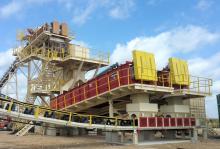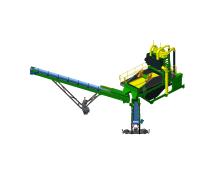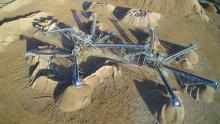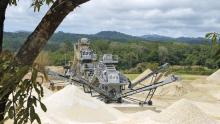
A requirement to make the best use of all extracted material, along with tougher aggregates specifications, is seeing an increase in the use of washing equipment.
The latest technology from manufacturers also looks to minimise the impact on energy and water consumption while offering quarry operators the opportunity to produce quality sand.
In Germany, mobility was the key when Anton Klee of Bad Beisig, which overlooks the River Rhine some 35km south-east of Bonn, was looking for a washing plant.
The company’s natural sand and aggregates operation opted for an AggreSand 165 from
“We started here in 2002 and our current operation has a life of about 18 months to two years, and we are already planning our new site nearby, so it is important that we have here the right equipment that is easy to move when necessary,” says Lars Dahlhoff, grandson of the company founder, who now runs the company.
Material to produce a variety of aggregates and sand is taken from a small lake at the Bad Breisig site, and is excavated using an old Eder excavator or a dredging machine, whose drag line goes down 6-8m. Oversize material (+80mm) is separated out and this is used to build up a stockpile for later crushing and processing through the AggreSand. Minus 80mm goes straight into the washing system.
“The material that we drag out of the lake is not sticky, which is good,” says Dahlhoff.
As well as sand (0-2mm) other materials gained from the washing process in the AggreSand 165 are 2-8mm, 8-16mm and 16-32mm, and the company processes between 800-1,000tonnes of material each working day, with the products being sold for construction materials or used in-house by Anton Klee for concrete production.
The AggreSand 165, which is fully automated and fully modular, was installed in mid-August, 2015, just two months after Christophel received the order. It requires very little by way of foundations, and took four days to set up “out of the box.”
Capable of producing three aggregates and two sand products, the AggreSand 165 is radio-controlled and is built for containerised transport, being pre-wired and pre-plumbed.
The system at Bad Breisig has a two-deck hopper, which is fed with material by a
At Anton Klee the AggreSand 165 is processing about 160tonnes of material an hour and can produce up to 120tonnes of sand an hour if required, with the wheeled loader driver operating the unit via the remote control, which is one of a number of options supplied by Terex.
“For example if he sees a stockpile is starting to build up he can move the radial conveyor to start another stockpile,” says Dahlhoff.
“The screen media is easy to change on the AggreSand, and the pump is also easy to get at. It simply slides out of the machine on skids.”
Telemetry used on the machine is in real-time, and it does a variety of things, including giving cyclone information, and feed rate.
The system uses a catchment box for sand and water and a pump to take material to the cyclone box where the sand is washed out. Water is piped away to a settlement pond.
Washed sand goes out of the bottom of the stockpile and it is very wet. In the AggreSand 165 it falls to the bottom with dirty water at the top.
“The dewatering screen receives sand and its job is to encourage the water to fall though and it comes out reasonably dry,” says Dahlhoff.
“The vibrating dewatering screen is a polyurethane box that allows water, not sand, to fall through.”
Meanwhile,
Kilgore uses a wash plant to process raw feed material and make a concrete sand product, but it found it was losing a lot of potential product through the overflow of the existing screw washer.
“We were losing a lot of our fines into our pond instead of being able to capture that and make it a sellable product,” says Mike Sosa, foreman at Kilgore.
The loss of the valuable sand product meant that the company was also losing out on potential profits. So to combat this issue, it decided to look for a solution that would allow it to do more with its material.
To improve sand recovery, Kilgore reached out to McLanahan Corporation who carried out laboratory tests to determine how much product size sand was in the material. With the provided flow rates, it custom-engineered a solution for Kilgore.
The solution fit Kilgore’s existing screw washer and sump without forcing it to greatly increase its physical and environmental footprints.
The system includes a McLanahan pump, separator and dewatering screen at the screw washer’s product discharge chute. McLanahan says it was able to engineer the system to utilise the customer’s existing sump.
Overflow from the screw is collected in the sump, from which the McLanahan pump feeds the separator, which then makes a cut and discharges the recovered solids back into the sand product on the dewatering screen, which further dewaters the screw washer and separator product, producing a drip-free sand.
Since the start-up of the new fines recovery system, Kilgore says it has seen benefits and improvements to its operation. It has increased its tonnage on the belt by over 30tons/hour (27.2tonnes/hour) , and is producing a dryer product at 85% solids, an improvement of ~10% less moisture in the product.
Kilgore says it is also able to retrieve more material instead of sending it to the pond, helping to increase its product yield and profitability as well as spending less time cleaning out the pond.
“The McLanahan system is quite simple maintenance-wise. You have very few moving parts and the parts that you do need to service regularly are easily accessible,” says Sosa.
“The McLanahan system that we put in, and like I say looking over all the options, was, in my opinion, the smartest way to address the problem we were having and to simplify the process that we do here.”
Family-owned quarry operator
The nominal 200tonne/hour capacity was rarely being achieved by the existing set-up for a variety of reasons, most of which could simply be put down to age and the greater demand for maintenance and servicing of an outdated design, so it was decided to take down the old machinery and renew the plant completely.
The task was contracted to CDE with construction starting in early 2015. On completion the fully automated plant is said to have achieved its designed maximum throughput of 250tonnes/hour, and “would reach peaks of 270tonnes if utilising virgin material rather than recycling the 10mm and 6mm through a vertical shaft impact (VSI) crusher for increased sand yield.”
Smiths Bletchington also wanted extra flexibility in producing aggregates to particular specifications, especially sand, along with a greater consistency in operation and energy efficiency.
The VSI works alongside a Hydrocyclone unit to produce two grades of sand which may or may not be recombined after separation, depending upon market demand.
The virgin material extracted by Smiths is a reasonably consistent mixture of sand and larger aggregates found in the alluvial deposits typical of the Thames Valley.
Although pre-screening will extract the majority of the sand from the mix, a large capacity log washer, the AggMax 151R, is required to remove grains that may still adhere to the shingle. Sand yielded by the process joins that from the pre-screen section before both streams enter the Hydracyclone unit, and the cleaned aggregate ejected from the log wash can be separated into three different grades or diverted to the crusher as required.
Processed stone from the crusher is reunited with the main flow of gravel before it enters the final screening box.









